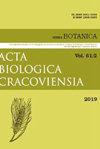部分葱属植物鳞茎的细胞形态、超微结构及其诊断价值
IF 0.5
4区 生物学
Q4 PLANT SCIENCES
引用次数: 7
摘要
采用光镜和扫描电镜对46种葱属植物鳞茎的细胞形态和超微结构进行了观察,以确定其显微形态学特征的诊断价值。本研究考察了这些性状的多样性,评价了它们在不同分类水平(种、段、亚属)上的有用性,并将结果与最近的属内分类进行了比较。提供了所调查物种的详细特征,并指出了在鳞茎被膜细胞中存在草酸钙晶体的分类群。结果表明,葱属植物的某些鳞茎被性状具有重要的分类学意义,因为它们在同一种的标本之间的差异可以忽略不计;它们可以成为物种描述和确定关键的有用元素。Allium亚属Allium显示出相当大的鳞茎被超微结构和六角形或细长的细胞模式的变化。超声形态的差异足以区分Amerallium亚属中的物种。三个亚属(Anguinum, Butomissa, Reticulatobulbosa)的特征是纤维被膜和网状超声。具有厚壁的矩形至椭圆形细胞,使鳞茎被具有几乎穿孔的结构,是葱属植物的特征。葱属(Allium Melanocrommyum)和葱属(Polyprason)未发现特异性模式。微scordum亚属(Allium monanthum)唯一的代表性植物显示出明显的人字形超微结构。葱亚属的鳞茎代表可以通过它们的线性超微结构来区分,它们遵循细长细胞的长轴。鳞茎鳞茎的超微结构和细胞形态表现出一定程度的差异性。这些特征对菊苣属植物的分类学划分、种系确定和进一步研究菊苣属植物间的亲缘关系具有一定的参考价值本文章由计算机程序翻译,如有差异,请以英文原文为准。
Cell Pattern and Ultrasculpture of Bulb Tunics of Selected Allium Species (Amaryllidaceae) and their Diagnostic Value
Cell pattern and ultrasculpture were examined by light and scanning electron microscopy in bulb tunics of 46 Allium species to determine the diagnostic value of micromorphological characters. The study examined the diversity of these characters, evaluated their usefulness at different taxonomic levels (species, section, subgenus), and considered the results in relation to the recent intrageneric classification of the genus. Detailed characteristics are provided for the investigated species, and taxa showing the presence of calcium oxalate crystals in bulb tunic cells are indicated. The results suggest that several bulb tunic characters are of taxonomic significance in Allium as their variation between specimens of the same species was negligible; they can be useful elements of species descriptions and determination keys. Allium subgenus Allium shows considerable variation of bulb tunic ultrasculpture and hexagonal or elongated cell patterns. Differences in ultrasculpture are sufficient to distinguish species within the Amerallium subgenus. Three subgenera ( Anguinum , Butomissa , Reticulatobulbosa ) are characterized by fibrous tunics with reticulate ultrasculpture. Rectangular to elliptic cells with thick walls, giving the bulb tunic an almost perforated structure, are characteristic for Allium subgenus Cepa . No specific pattern was found for Allium subgenus Melanocrommyum and Polyprason . The only representative of subgenus Microscordum ( Allium monanthum ) showed distinct herringbone ultrasculpture. The bulbs of Allium subgenus Rhizirideum representatives can be distinguished by their linear ultrasculpture following the long axis of the elongated cells. Allium bulb tunic ultrasculpture and cell pattern show some degree of variability. These characters are of potential use in taxonomic delimitation, species determination and further study of the relation- ships between Amerallium
求助全文
通过发布文献求助,成功后即可免费获取论文全文。
去求助
来源期刊
CiteScore
3.00
自引率
0.00%
发文量
0
审稿时长
>12 weeks
期刊介绍:
ACTA BIOLOGICA CRACOVIENSIA Series Botanica is an English-language journal founded in 1958, devoted to plant anatomy and morphology, cytology, genetics, embryology, tissue culture, physiology, biochemistry, biosystematics, molecular phylogenetics and phylogeography, as well as phytochemistry. It is published twice a year.

 求助内容:
求助内容: 应助结果提醒方式:
应助结果提醒方式:


